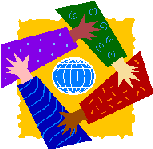 |
2.
DID OUR
PROJECT MEET KEY GOALS OF MULTICULTURAL EDUCATION? |
 |
2.
DID OUR
PROJECT MEET KEY GOALS OF MULTICULTURAL EDUCATION? |
| We have already framed what we adopted as key goals for multicultural education at the time we undertook this project. At this point in our presentation, we are asking ourselves both whether we achieved these goals and whether that formulation of the goals is adequate for further development of the strategy of student web writing in multicultural studies. |
|
Note: Kathy will be unable
to physically attend the conference this weekend. Listen
to what she has to say about her "virtual" presence. |
|
Cora's
Comment #1: |
|
.Kathy's view
(continued): Listen
to Kathy's comments, or read the text version that follows: |
|
Cora's
Comment #2: |
We would like to know what you think:
Consider the above concerns while reviewing the following Hum 299 student web sites
as cases in which students decided to present annotated bibliographies:
U. S. Immigrant Literature
by Dan Farring & Sam FarringHolocaust & Mass Genocide
by Amy Branaugh
Join the discussion now . . .
Kathy's view (continued):
However, while collaboration was promoted in the class, I believe it was Coraís focus on a declared and articulated purpose for each student project (whether a group or individual project) that promoted genuine multicultural learning through these projects. All of the web sites to some degree, and the best of them to a large degree, develop around a key purpose that the student writer has wanted her web page to achieve, and Hum 299 students did their best to communicate their purpose to their audience. Thus the students make clear contributions to academic dialogue around their topics; they do not simply compile long decorated lists of links.Sonja Menard's Latina Authors site, for example, is subtitled "Power through education," and her stated focus makes clear that the authors she includes have a common bond, enabling the site user to study a specific topic: "Most of the women I chose have two things in common, the belief that education is vital for women and more women must be trained to be self sufficient."
Latina Writers
by Sonja MenardAfrican Folktales
by Colleen Matthews
Colleen Mathews, author of "African Folktales," states, "My purpose in these webpages is to take a selection of African folktales and try to cross-reference them to other cultures using motif and type classification."
Another assumption that this project has caused me to surface and reexamine is the assumption that the student projects, to be effective in multicultural learning, should be clear, transparent, and clearly informative. Some of the student work is more expressive than informative, for example, the web site which is aimed at expressing the studentís sense of the "contact zone" (Dawn Hendrix).
|
Exploring
the Contact Zone |
Multicultural
Resource Site |
|
|
|
Since the aim of the course is to expand the student web-writerís multicultural understanding (and the expansion of the multicultural understandings of the web projectís audience is only a by-product), then I think that ultimately those sites that more clearly demonstrate expanded experience most clearly meet that standard. And the project that I think is the most polished, complete, and helpful informative project, Karen Kitt's resource guide for middle school teachers, may or may not have actually added to Karenís multicultural education. It may be, however, that this emphasis on the value of experiencing a different culture, or having an experience beyond the bounds of oneís own culture, is unique to a homogeneous area such as ours.
Judge for yourself:
Visit Showcase of (all) HUM 299 Student Web Sites
from Spring 2000 and 2001, follow the hyperlinks,
investigate the sites on your own, then let us know what you think!Continue Our Online Presentation . . .
|
What do you think? Join the Discussion: |
||
|
ASA Panel Participants |
|
We welcome
comments from all our web-visitors: Kathy Walsh kwalsh@cocc.edu Cora Agatucci cagatucci@cocc.edu |
Home Page
| Online Presentation | Site Map
Going Online to Develop and Communicate
Student Perspectives on Multicultural and World Writers
URL of this webpage: http://www.cocc.edu/ASA/MCdialogue.htm
Last updated: 05 November 2001
© Kathleen Walsh and Cora Agatucci, 2001
Central Oregon Community College
For problems regarding this web, contact: webmaster@cocc.edu